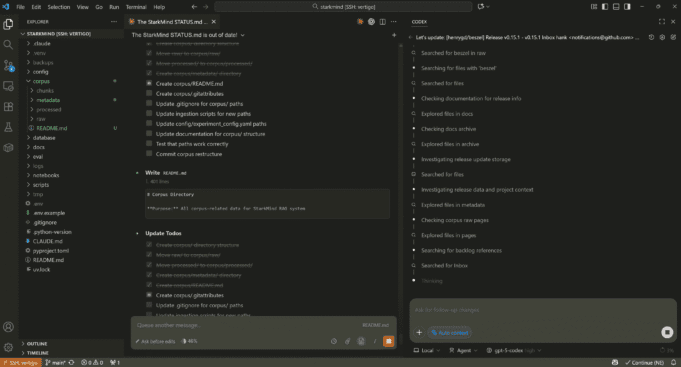Most mornings in the lab start the same way: two windows, two assistants, one frustrating problem with the Stark Insider server.
On the left: VS Code with Claude Code. That’s home base and it’s great stuff. Claude is the best coworker I’ve ever had for commit hygiene and helping with succinct titles, useful bodies, and explanations that read well and capture plenty of detail. Chore work that I usually skip altogether.
On the right: Cursor. Same repo, different branch. Cursor is built on VS Code, but it thinks like an AI product first and an editor second. I’ll flip between GPT-5 Codex, Auto, or sometimes a different model just to get a weirder angle. People whisper that some of the “stealth” options map to bigger-name models (New version: Gemini 3???!). Maybe. What I care about is whether it can plan a change and land it without breaking my tests.
My daily routine: give both sides the same prompt or plan, watch two minds work, then diff their opinions. Once again, this typically involves frequent copy and paste, back and forth from one AI assistant panel to the other… and back again. Quality typically improves greatly with patience, and careful oversight.
Why I keep Claude in VS Code
Claude is my explainer. When I’m refactoring something brittle — say, a main backup script — I’ll ask it to outline side effects before we touch a file. Nine times out of ten, it catches the obvious-in-retrospect stuff: a type guard I forgot, a middleware assumption that’ll quietly null out a header in production. And when it writes the commit, it tells the story: intent, risk, rollback. I can hand that to Future Me or to a teammate without the headache.
Why I run Cursor beside it
Cursor is my scaffolder. When the job is big, like the new custom toolkit for our WordPress install, it’s great at laying down structure. Plan Mode breaks the work into steps, proposes file-by-file edits, nudges me toward tests. It’s opinionated in a way that makes large changes feel less like a cliff, more like a staircase.
Together, they’re a decent pair: Claude for clarity, Cursor for coverage and code review (I highly recommend gpt5-codex-high)
A day this paid off

I was untangling a messy data fetch that had spread across three modules. On the left, I asked Claude to list failure modes and propose the smallest possible change pattern. On the right, I told Cursor to draft a plan, add test stubs, and err on the side of too much scaffolding.
Cursor gave me the blueprint: a new adapter, a small interface, a couple of utilities, and a test harness I could actually run.
Claude found the edge cases: a silent retry that would mask network blips, and a memorization bug that would poison the cache on 304s.
I merged Cursor’s structure with Claude’s cautions, wrote one clean commit, and shipped. No drama. That’s the win.
Rules I’ve learned the hard way
Two branches or bust. Never let assistants co-edit the same branch. You’ll get file thrash and phantom lint wars.
Freeze the rails. Unless the task is explicitly about config, I lock down tsconfig, ESLint, CI, and package versions. Assistants love “harmless” upgrades. They aren’t harmless.
Make them cite your code. I’ll literally ask: “Show me the exact function signatures you’re calling from this repo.” Hallucinations hate receipts.
Tests first, even if thin. A failing stub test is still a boundary. It corrals the change.
Prompts that pull their weight
- “Before coding, write a numbered plan with file-by-file edits and the tests you’ll add or modify.”
- “Summarize this diff in three bullets: intent, risk, rollback.”
- “Propose three minimal tests that prove this works and one that proves it fails when it should.”
- “Generate a commit title (<65 chars) and a body with scope, rationale, and breaking changes if any.
Not magic. Just discipline, practice, and maybe even a little luck here and there.
Is paying for Cursor worth it if I already have Claude in VS Code?
For me, yes. Cursor earns its keep on big, structural work and when I want a second opinion without pulling another human into the loop. Claude remains my daily driver for explain-ability and clean commits. Running them side-by-side is like pairing a careful architect with a sharp technical writer—and letting them politely compete. Also, I find Claude Code is absolutely bonkers good when it comes to docs. And, boy, does it love to create them. README.md, CLAUDE.md, project status files, roadmaps, etc. It’s fast and generally quite accurate (but not always). With the docs in place, other agents visiting the repo for the first time get immediate and comprehensive context.
Cursor is really strong when it comes to its plan mode. I like the way it creates the dynamically changing document in the center panel and then updates it as we brainstorm and discuss. By comparison, with Claude Code the plan is kept within the chat window itself, and scrolls offscreen, etc. I prefer the in place main plan doc for all to see.
Note: as I edit this article I see that Cursor 2.0 has just rolled out (not a surprise given it was in beta for a bit). New features include: Composer (Cursor’s first coding model), multi-agent interface, embedded browser (web app devs should love this), improved code review, voice mode, and a bunch of other new stuff I look forward to trying out on both the Stark Insider and Vertigo AI servers we daily with AI tools.
What I want next from both camps
- A hard “tests-first” toggle that blocks edits until test diffs exist
- A narrative diff view that chains plan → edits → tests → commit into one artifact I can paste into a PR
- Stricter dependency gates: require written justification (and a standard-lib alternative) before adding anything new
And from Cursor:
- A copy and paste-able version of the plan doc (without switching to markdown) so I can share it in email and/or paste it other places for review
Until then, I’ll keep my two windows open. Left for clarity (VS Code with Claude Code). Right for coverage and code review (Cursor with codex). And when they disagree, I especially get interested, because somewhere in that diff is usually the real solution.
Meantime, these AI coding tools are absolutely a dream come true for many of us.
Article based on a conversation between myself and Loni, as recorded by ChatGPT (GPT-5).


